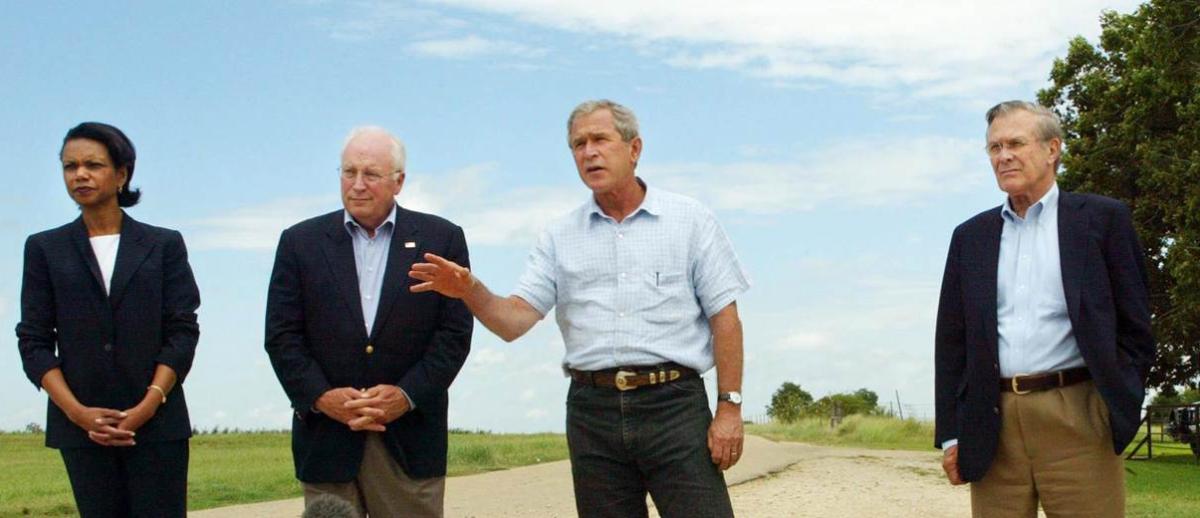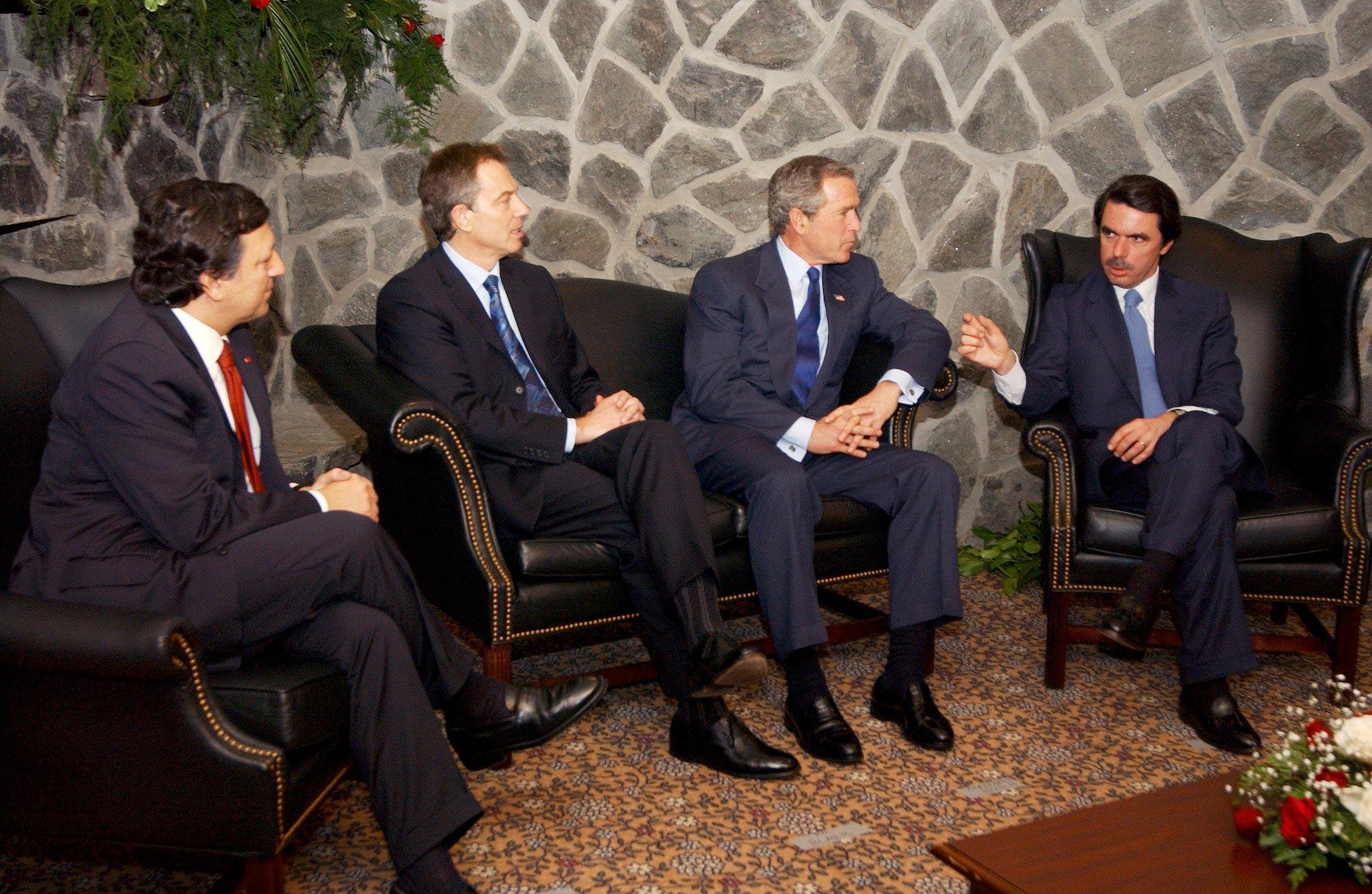The Resurgence of Hegemonic International Law
archive


Condoleezza Rice, Dick Cheney, George W. Bush, and Donald Rumsfeld, 2004.
The Resurgence of Hegemonic International Law
There is little doubt that 9/11 has shifted the tectonic plates of geopolitical and normative space. This shift is characterized by an increasingly assertive form of hegemonic conduct through ‘ad hoc coalitions of the willing’ and by a corresponding a la carte approach to the multilateral institutions, rules, and processes that guide interstate and transnational action.
The US is at the center of these developments. The 9/11 attacks came at a time when the country still enjoyed the benefits of the unipolar moment that had emerged with the end of the Cold War. In fact, several advocates of US dominance argued that the country had a unique opportunity to reshape global norms by unabashedly seizing the unipolar moment.1 In the legal realm, the unipolar moment pointed to the resurgence of hegemonic international law (HIL) and the extent to which the dominant power could harness the collective processes of international law in order to address the challenges posed by transnational terrorism.
The process that unfolded after the 9/11 attacks was shaped by a US-led ad hoc coalition of states which sought to adapt international law to the contemporary challenge of terrorism by circumventing “cumbersome traditional lawmaking processes”2 in order to battle “terrorism” via the adoption of United Nations Security Council (UNSC) Resolution 1373, which was fashioned by the elite powers of the Council but was binding on all members of the UN, unconstrained by geographical and temporal considerations.
“Coalitions of the Willing”(CotW) constitute a more recent variant of HIL. Such coalitions “are informal groups of like-minded actors,” led by a dominant state, that are engaged in coordinated action aimed at the pursuit of collective goals.3 In the effort to achieve their intended goals, coalitions of the willing tend to have a very selective approach to the tools and processes provided by international law. In some cases they may engage with these tools and processes (for example with treaty mechanisms), in other cases they may by-pass them in an effort to coordinate their activities “through informal processes that offer sticks and carrots to the non-participating states.”4
Although states still seek to institutionalize cooperation in formal organizational settings by bringing on board as many states as possible before key decisions are reached on the specific purposes and aims of the mission, the coalitional form reverses this process: the purposes and aims are determined in advance by key players and this determination shapes the membership of the coalition. This is best encapsulated in Donald Rumsfeld’s famous statement concerning the Bush Administration’s ‘coalition of the willing:’ “When you begin an invasion, a rule is 'the mission should determine the coalition, not the other way around.' You should not first assemble a coalition with many different views and then try to determine the mission. That leads to a lack of clarity as to the mission.”5

Portuguese Prime Minister José Manuel Durão Barroso, British Prime Minister Tony Blair, US President George W. Bush, and Spanish President José María Aznar meet in the Azores on 16 March 2003, two days before commencement of "coalition" bombing of Iraq. (Source: Wikimedia)
In this context, international cooperation is envisaged as having an inside/outside type of engagement with treaty structures and formal institutions: the inside facet entails selective engagement with institutions that enable the dominant power to make law for the others, without being subjected to its restrictions. The outside facet entails by-passing formal institutions and treaties in favor of informal arrangements whose actions reinforce the already existing hierarchy in the international order.
In light of the above, we can identify the following key features of the coalition of the willing (CotW) form of HIL:
Membership: Informal grouping(s) of states led by a dominant state or states
Key determinants: military and economic power
Key characteristics: Selective approach to the tools and processes of international law; primacy of the coalition’s mission
Main manifestation: growing interaction between informal norms and processes and formal rules and processes
Main consequence: reinforcing instrumentalist uses of international law
In the beginning was… UNSCR 1373
Any examination of the normative implications of 9/11 and its aftermath should begin with UNSCR 1373, which seeks to demarcate the relevant terrain and identify some of the main tools and modalities for addressing the challenges posed by international terrorism. Some analysts view it as the launching of UNSC in the role of ‘legislator,’6 given the sweeping nature of the resolution’s reach both in terms of the issue areas of mandated action and its spatio-temporal settings.
The process that unfolded after the 9/11 attacks was shaped by a US-led ad hoc coalition of states which sought to adapt international law... by circumventing “cumbersome traditional lawmaking processes”...
There are several important features of UNSCR 1373 that render it an exemplary manifestation of CotW lawmaking and set the stage for several of the key attributes of hegemonic conduct exhibited during the ongoing ‘global war on terror.’
First, UNSCR 1373 was adopted under Chapter VII. This reflected a desire to create legal obligations for all states via a process that would by-pass the formal and often cumbersome route of treaty-making. This approach rendered the substantive provisions of the resolution mandatory to all states without the possibility of staying out of the emerging counterterrorism regime, or of objecting/attaching reservations to some of the provisions, options that would be available in the context of treaty-making. In addition, the deliberative process usually associated with treaty-making and the negotiated compromises necessary in order to ensure the widest possible participation was thereby eliminated. It is instructive to note UNSCR 1373 was adopted at a UNSC meeting that lasted 5 minutes.7
Second, the operative paragraphs of UNSCR 1373 are laced with references to very broad terms such as “necessary steps,” “appropriate measures” and “effective controls:”8 The open-ended language of key provisions would ensure maximum flexibility in the adoption of measures by the main players involved.
Third, UNSCR 1373 exhibited an a la carte treatment of a key legal instrument: the International Convention for the Suppression of the Financing of Terrorism. More specifically, the resolution placed a lot of emphasis on the financing of terrorist acts. Yet, UNSCR 1373 included the Convention’s enforcement provisions that suited the counterterrorist agenda, and omitted key constraining provisions such as those relating to the rights of persons accused of terrorism-related offences, and to the requisites of international human rights law.9
Fourth is the absence of spatial and temporal limitations. UNSC 1373 applied to all member states of the United Nations system and the mandated measures were expected to operate, once adopted, in perpetuity.
This approach set the stage for the a la carte treatment of other legal instruments, such as the UN Convention against Torture and Other Cruel, Inhuman or Degrading Treatment or Punishment (CAT). The emphasis on and the debate surrounding the prohibition of torture—by raising the bar on what constitutes torture and by keeping the exact meaning of other forms of ill-treatment unclear/indeterminate—led to a shift in the discourse. This shift was manifested in the association of inhumane treatment with torture, an association that left the door open for the acceptance of less abusive forms of treatment under the necessity and self-defense arguments in a situation of global emergency. The term ‘enhanced interrogation techniques’ (EITs) was offered as an alternative, ‘kinder, gentler’ form of interrogation that could achieve the desired results without falling afoul of the prohibition of torture. By linking these methods to the need to protect national security, the terrain par excellence of state authority, the state was expected to take the leading role in framing/reframing ‘the threat’ and the range of appropriate responses to it.
UNSCR 1373 was adopted under Chapter VII. This reflected a desire to create legal obligations for all states via a process that would by-pass the formal and often cumbersome route of treaty-making.
It is instructive to recall that the Bush administration drew a sharp distinction between “torture,” which it claimed was banned under both international and US law, and EITs. In addition, in a series of legal memos that were drafted by Bush administration lawyers and were subsequently released by the Obama administration, it was argued that EITs did not even constitute “cruel, inhuman, or degrading treatment” since, among other things, they were applied under certain safeguards.10 However, this was a questionable qualification, to say the least: there is nothing in CAT and the Committee against Torture’s case law that conditions the characterization of a particular technique on the basis of whether it is supervised or not. To put it another way: if we were to agree, for the sake of argument, that subjection to extended ‘stress positions’ does not constitute torture but cruel/inhuman treatment, the fact that its application is supervised does not transform it into a non-cruel/inhuman form of treatment and therefore authorize it as a permissible law enforcement technique.

David Addington, chief of staff for Vice President Dick Cheney, left, and 'torture memo' author John Yoo, former attorney in the US Department of Justice Office of Legal Counsel, in 2008. (Source: Susan Walsh/AP)
This attempted framing was facilitated by three key factors (two of which antedated 9/11). The first related to the loopholes provided by article 3 of CAT: For example, a state may return or extradite a person to another country with the knowledge that the person affected by that process would be in danger of being subjected to cruel/inhuman/degrading treatment. A second factor concerns US reservations attached to the CAT that restricted its application “only insofar as the term `cruel, inhuman or degrading treatment or punishment' means the cruel, unusual and inhumane treatment or punishment prohibited by the Fifth, Eighth, and/or Fourteenth Amendments to the Constitution of the United States.” The third factor related to the framing’s receptivity: in particular, the eagerness of many authoritarian regimes (and other governments) to embrace EITs as a way to bring forward practices akin to torture, whose existence they routinely denied prior to 9/11.11
Concluding Remarks
The process unleashed by the adoption of UNSCR 1373 marks the resurgence of hegemonic international law. In particular, UNSCR 1373 constitutes an exemplary manifestation of a particular form of HIL: Coalitions of the Willing (CoTW) lawmaking. This form centered on the US-led instrumentalization of the UNSC for the launch of a major legislative initiative by circumventing traditional international lawmaking processes. While the basic parameters of this initiative were shaped from above, it was also enabled from below by many other member states that eagerly seized the opening provided by the 1373 process to ‘launder’ questionable, to say the least, legislative initiatives and enforcement practices through the said process.12
1. A typical proponent of this view was the late Charles Krauthammer: “After a decade of Prometheus playing pygmy, the first task of the new administration is precisely to reassert American freedom of action… The new unilateralism recognizes the uniqueness of the unipolar world we now inhabit and thus marks the real beginning of American post-Cold War foreign policy.” See: “The Bush Doctrine: ‘new unilateralism.’” The Houston Chronicle, June 8, 2001. https://www.chron.com/opinion/editorials/article/Krauthammer-The-Bush-doctrine-new-2055304.php [EMBED LINK] For a different view arguing that the US should use this opportunity provided by the unipolar moment to renew its commitment to multilateral rules in exchange for cooperation by other states, see G. John Ikenberry, “Getting Hegemony Right, The National Interest, Spring 2001, pp. 17-24.
2. See Eyal Benvenisti, “Coalitions of the Willing” and the Evolution of Informal International Law (on file with the author).
3. See Alejandro Rodiles, Coalitions of the Willing and International Law. The Interplay between Formality and Informality (Cambridge University Press, 2018), p. 2; and Benvenisti, ibid.
4. Benvenisti, p. 2. A good example of a selective use of a treaty in order to create a coalition of like-minded states on the issue of accountability is the US’s strategy of pursuing the signature of Bilateral Immunity Agreements (BIAs) with ‘willing states’ parties to the Statute of the International Criminal Court. These BIAs, based on article 98 of the Statute, are designed to ensure that no US citizen would be subjected to the jurisdiction of the ICC.
5. Spiegel Online, Interview with Donald Rumsfeld. ‘Do I Have any Regrets? Of Course I Do;’ http://www.spiegel.de/international/world/interview-with-donald-rumsfeld-do-i-have-any-regrets-of-course-i-do-a-754847.html
6. Paul Szasz, “The Security Council Starts Legislating,” American Journal of International Law, vol. 96 (4), 2002., pp. 901-905.
7. United Nations Security Council, 4385th meeting, S/PV.4385, Friday, 28 September 2001.
8. On this, see Benvenisti, note 2.
9. On this point, see Jose Alvarez, “Hegemonic International Law Revisited,” American Journal of International Law, vol. 97(4), 2003, pp. 873-888.
10. One such safeguard cited was the presence and supervision of the process by qualified personnel (medical doctor/psychologist) authorized to intervene and stop the application of such techniques if they were to exceed the ‘permissible’ level.
11. See, among others, Rosemary Foot, “Torture: The Struggle over a Peremptory Norm in a Counter-Terrorist Era,” International Relations, vol. 20(2), 2006, pp. 131–151.
12. For more on this point, see George Andreopoulos, “Hegemonic International Law (HIL) and Counter-Terrorism,” Paper presented at the American Political Science Association Convention, Boston, August 30-September 2, 2018



